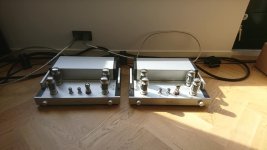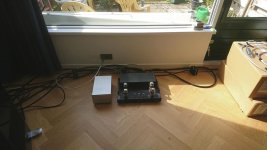a.wayne ,
“@TDSS,
Hi Bob i have a question, could you explain or give your opinion as to why class-D amps have such poor squarewave responses and is this related to what is percieved as a wonky top end..”
Thanks for asking. I’ll be happy to do what I can to answer your questions - for what it's worth. As far as “poor square waves” go, I first need to be certain with regards to exactly what you mean. If you are referring to the typical overshoot and ringing that Class-D amps exhibit, then I believe I can answer that. Although, if a given amp simply does not exhibit a sufficient Rise Time, then that just means that the amp’s audio bandwidth is limited to some upper frequency, possibly even down into the audio band below 20KHz.
As an example, many manufacturers will test with a 10 KHz square wave as a means to check for amplifier stability at high frequencies. Excessive overshoot and wringing when driving a reactive load (moderately capacitive or inductive) can mean the amp is not sufficiently damped and may be prone to oscillation at some extreme high frequency beyond the audio band. This can be just as true for linear amps (Class A, A/B, etc.) as those of Class-D/Switching types, and in certain ways maybe even more so. In such cases, if the amp does “break out” into oscillation, it’s usually only a matter of milliseconds before it self-destructs.
On the other hand, a bit of overshoot and ringing exhibited by a Class-D/Switching amp is considered to be somewhat “normal,” as typically it is all but impossible to completely eliminate the switching noise generated by the output transistors. If you analyze the frequency content of that energy you will find that it is usually some harmonic of the amp's fundamental switching frequency, which is almost universally well beyond the audio band and completely inaudible.
BUT… that doesn’t mean that energy doesn’t have some effect on the final sonic presentation. In fact, “everything affects everything to some degree, it’s just a matter of degree.” The question I have is: “How does that energy interact with the speakers (drivers and crossover) and the speaker cables?” Specifically, does it cause any type of complex modulation and/or inter-modulation effects that would generate a-harmonic (not harmonically related to the music) “side-bands”? I’m a-think’n it just might.
Then again, many of us love old high-quality analog recordings and those (other than direct-to-disc) where made using analog tape recorders. AND those virtually always employed application of a low-level “tape bias frequency” (usually somewhere near or around 200khz) that was laid down on the tape along with the signal being recorded. I won’t get into why, other than the fact that the bias was necessary to achieve a reasonable high frequency response.
Are the two the same? No… but they are similar, enough so that based on the tape bias situation you’d think that the HF noise generated by Class-D amps should do no harm either. Whether it does or not, the jury is still out as far as I am concerned, but if you ask most any “academic-type” engineer he’ll likely tell you that the HF noise has no audible affect whatsoever. At least that’s what he’ll say when you ask him to figure out a way to get rid of it. Why? Humans don’t like their limitations being rubbed in their face and will often claim doing a certain thing is simply not possible – rather than admit their own ineptitude.
Of course, it all comes down to distortion at some point. When it comes to that stuff, simple numbers are all but meaningless. What you absolutely NEED to know is what the total Distortion Profile (DP) looks like. In other words, what does the frequency response of the distortion products look like if they are plotted on a typical frequency vs. magnitude graph? That is a graph we are all familiar with, and we pay most attention to them when evaluating the response of a loudspeaker.
OK, so you can easily imagine that such a graph may well have a number of peaks and dips all along its length, and with respect to amplifier distortion measurements, they usually do. So let’s use the speaker comparison a little more to get a better picture.
So for “hypotheticals,” we’ll say a given loudspeaker has a response graph that exhibits a continuous rise from say... 3 KHz on up to 20 KHz. In that case, we’d expect that the speaker would sound very bright, with too much energy in the highest octaves. Well, if a given amp’s DP curve does the same thing, then you’d likely perceive the sound that it reproduces to be “too bright” and possibly irritating as well.
Nevertheless, if you take a look at that same amp’s STANDARD Frequency Response graph (which is actually the same thing as the graph of a typical loudspeaker Frequency Response measurement), you will find that it might very well measure with little more variation than +/- ½ dB from 20 to 20KHz. Therefore, just looking at that alone you would never know there might be a problem, let alone what the amp will actually sound like.
Now to complicate things even more, the DP will vary dynamically. At low output power-levels there will be a certain shape to the curve, and as the power levels increase the shape of the curve will change. So that means the various distortion products are constantly changing along with the output power level, as the ongoing dynamics continually change in the music.
Then like one more bullet for good measure, let’s add another necessary level of complexity just to make sure the thing is really dead. Besides all of the above, we have to track how the DP changes with respect to frequency and the how the varying impedance of the loudspeaker affects current draw from the amplifier. Along with that, we have back-emf being generated by the speaker and energy storage/release driving signals back to the amplifier as a result of its complex reactance, hysteresis effects and magnetic materials saturation.
YIKES! Even Bill Gates would have his hands full trying to develop an all-encompassing test that would quantify all of that! In fact, it would take some serious Artificial Intelligence computing power to even try, and even then, it still wouldn’t really tell you the whole story.
So I guess the next best thing is to use the Natural Intelligence located between your ears and just LISTEN… because that’s about all we have to go by. Then we all know how listening is a subjective process, so hence we find the many different audio products out there to choose from, not to mention the headache of trying to glean some reasonable amount of truth in an industry dominated by hype.
At this point, we find ourselves back where we started. Why do Class-D amps have a “wonky” top end? I dunno. Do they? If so, it’s most certainly has something to do with their DP, and I’m guessing it’s because in some amplifiers there are more complex HF distortion artifacts in the region above 3KHz. Is that situation unavoidable due to the nature of the technology? No, because personally I have heard otherwise, and I know others have too. You should hear a pair of our TDSS upgraded Ref-9V3s or possibly the NuPrime Evo-1, and maybe you’ll form a different opinion. I know that I can live with them playing night and day without developing any sense of listening fatigue, and I’ve been into high-end for over forty years, so go figure.
I’ll finish by making my point with a little story. Back when I was the Support Manager for NuForce I had a gentleman call me for some reason or another, and we got to talking. In the course of our conversation he told me that he just loved the sound of his NuForce Ref-9s and how he could tuck both of them under one arm as he went out the door. In particular, he mentioned how he got a real kick out of taking them to his various audiophile friends’ houses to do comparisons with their amps. He said, “I plop them down next to my friends’ huge, 100+ pound, mega-buck mono-block tube amps, hook them up, play some good music… and watch their jaws drop and their frick’n eyeballs pop right out of their heads in disbelief.”
So there ya go. What’s the truth of the matter? Whatever you happen to hear, I suppose. Perception is reality” – right? Why do you hear what you do? I’m betting it has something to do with the DP of the amp in question (most likely at high frequencies), or… your ears may be a little broken, or… your personal bias is skewing your perception so it’s simply your overactive imagination. Take your pick.

Take care,
-Bob
PS. The DP issue regarding amplifiers as outlined above holds true for loudspeakers (which happen to be particularly horrible) in most ways too, as well as every other component in your system. Therefore, if you weren’t already pretty much screwed trying to figure all this crap out before now…
HA! Welcome to the asylum!!! :boing:


